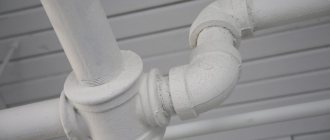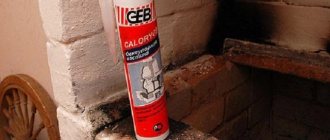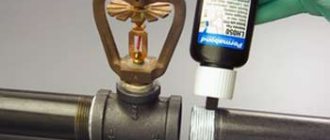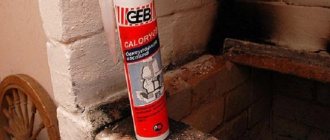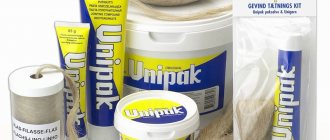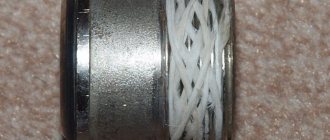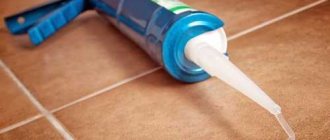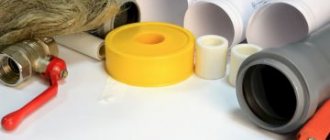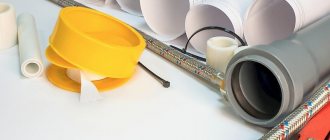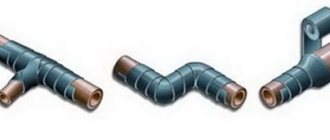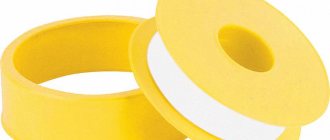Linen sealant
The oldest sealing material for threaded connections, the history of its use goes back decades.
The work of flax as a sealant is based on the swelling of its fibers under the influence of moisture. It should be used with great care to seal threaded connections of water pipes made of thin-walled materials. Swelling and then expansion of the flax fibers can cause a rupture at the pipe connection. The disadvantage of the connection is the destruction of organic flax fibers under the influence of moisture and weakening of the connection and moisture seeping through it.
In addition, due to constant moisture, metal parts begin to corrode, and when disassembling the area, they fail.
It is unacceptable to use dry flax as a sealant for water supply pipes operating under high pressure. In this case, water seepage will occur very quickly.
As an alternative, flax fibers impregnated with paints and varnishes are often used. This is a more reliable option, but not without its drawbacks. Since it is impossible to saturate flax 100% with paint, there remains the possibility of organic matter rotting and seal failure over a longer period of time. It is even more difficult to disassemble such an area.
It is more optimal to use flax in conjunction with silicone sealant for water supply pipes. In this case, the flax fibers are treated with silicone material. Assembly of pipes and connections is made easier. Such connections may be tightened if necessary. The use of silicone sealant ensures tightness of the water supply connections, even when the elements are not tightened all the way.
Plumbing tow
To carry out plumbing work you need a special tow - impregnated. This type of material is specially processed and is indispensable when repairing plumbing or heating systems. Tow is a decades-tested material that allows you to reliably join pipe joints and prevent leaks. The structure of the fibers makes it easy to wrap them around the thread; in addition, they perfectly absorb moisture, expanding when wet.
To achieve the most effective result, the tow should be treated with resin or special impregnation, but you should not apply too much of the solution, otherwise it will interfere with the natural expansion of the tow when it gets wet.
Plumbing thread
This is a synthetic material whose fibers are impregnated with a special non-drying compound. Has all the benefits of flax impregnated with sealant. Not subject to rotting, better protects against corrosion.
The use of plumbing thread as a sealant for connecting water pipes allows the positioning of elements with a reverse motion of up to 180⁰ (when using flax - only 90⁰). Incomplete tightening of elements is allowed, but sealing is maintained. Due to the fact that the thread is very thin, there is a large consumption of material. The only drawback is the high cost of the sealant.
How to caulk a log house
To caulk cracks in a log house, you need a material that does not allow heat to pass through and is capable of filling a narrow space. The methods of working with all materials are similar, but there are some nuances for each.
Natural materials
These methods of caulking a wooden house have been used for centuries and have not lost their relevance. Fibrous materials are used that retain heat due to the air cushion.
For the work, a special tool is used - a caulk. In appearance, it resembles a spatula, but with a thickened, non-sharp edge. There are 4 varieties:
- Typesetting for walls.
- Curve for corners.
- Fork-shaped (road worker) for twisting rollers.
- Breakable (wedge-shaped) - to widen cracks to make access easier.
The caulk can be replaced with a spatula, but you will have to use it carefully so as not to damage the material with a sharp edge. You can use wooden tools, including homemade ones.
Tow
Tow is the most common material for caulking a log house. Its main advantages are low cost and tight placement in the cracks. That's where the positives end. Tow does not clog well in cracks, gets wet and absorbs water, which reduces its effectiveness. All kinds of pests love it very much - moths, mosquitoes, flies. Tow sticking out of the cracks looks unsightly; additional costs for decoration are required.
Tow does not look very aesthetically pleasing Source dubki-house.ru
Jute fiber
It is much more convenient to use jute for caulking than tow. Due to the high resin content, these wood fibers are very flexible when inserted into cracks. These same resins do not allow jute to absorb water, provide an antibacterial effect, and repel insects. But the resins evaporate over time, and the fibers decrease in size, lose their elasticity, and become stiff. The cracks that were sealed appear again, and the caulk falls out of them. If jute is not stored correctly, it becomes unusable over time.
Flax and flax wool
Caulking a house from timber with flax is another old and proven method. A more modern flax-based material is flax batting. From flax he took softness and hygroscopicity, from batting - resistance to rotting, density and a large air cushion between the fibers. Linen wool not only retains heat inside the house, but also regulates the level of humidity. The disadvantage is that its ability to absorb moisture from the air when there is an excess and release it when there is a deficiency can lead to “pumping” street humidity into the room.
Linen batting can be secured with a stapler Source e-uteplitel.ru
Moss
Caulking the log house with moss will give the house an unusual look. Moss retains moisture and heat well, does not cake, does not shrink in size, repels insects and kills bacteria. You can collect the raw materials for caulking with your own hands, but before use you need to sort them, clean them of soil and insects, otherwise, instead of working material, you will end up with a breeding ground for unpleasant living creatures. The main disadvantage is that moss is stolen by birds for their nests.
Moss copes well with the task Source ff-s.ru
See also: Catalog of companies that specialize in home insulation
Felt
Caulking a timber house with felt will allow you to achieve several useful results at once - good insulation, vapor permeability and sound insulation. The house will be warm and quiet, and dew and frost will not settle on the walls, which have a bad effect on wood.
Natural felt can rot or become a haven for moths. The same material with the addition of artificial fibers is free of such disadvantages. It is convenient to work with both types of felt, but there is a significant drawback - it is the most expensive among natural materials, especially if it contains synthetics.
Artificial materials
Artificial insulation for caulking timber is varied. Some of them are similar in principle to natural ones, but unlike them they are not subject to rotting and getting wet, others have a fundamentally different structure. Each insulation has its own method of operation.
Artificial insulation does not rot Source textilespace.ru
Polyester fiber
PEV is a synthetic analogue of natural materials. This is a fibrous structure in which the main insulating material is an air cushion. In terms of the way it works, PEV caulking is reminiscent of punching a log frame with jute or tow. The advantage of synthetics is that these fibers do not absorb moisture and do not change their properties over time. Vapor permeability and thermal insulation properties are very high, and in terms of ease of use, polyester fiber is far superior to all natural analogues. The main disadvantage is that the price is too high.
Pre-compressed insulation tape
PSUL is an improved version of polyester fiber. In addition to all the advantages that synthetic insulation has, it has another important quality - high elasticity. The material can shrink and expand, which is very important during shrinkage of the house. Using PSUL eliminates the need for repeated caulking; instead, only minor corrections are required.
Wood sealant
This material for caulking a log house is not used independently, but only complements others. His task is to seal the cracks and correct the flaws of the caulk. It provides additional thermal protection, does not allow moisture to pass through, which is important if rotting insulation was used, does not allow pests to enter and partially compensates for the results of drying out of the insulation if it is susceptible to this.
Sealant in different packages Source 7lestnic.com
Liquid sealants
Available in suspension form. They are not used independently, only in conjunction with fiber materials. It will simply be forced out of the connection, this is especially noticeable in pipelines operating under high pressure. Used as a lubricant for connections of water supply elements. When choosing a drying agent, you need to pay attention to the fact that when it dries, it shrinks.
Anaerobic sealant is an exception.
This plumbing sealant for pipe connections dries in the absence of air without changing volume, protecting metal connections from corrosion and the water supply itself from leaks in the connections. High-quality fixation occurs with minimal sealant consumption.
Advantages of anaerobic sealant
- Hardening occurs as a result of polymerization. Excess is easily removed, as it does not harden in air.
- Good adhesion allowing the connection of plastic and metal pipelines
- The ability to use not only for sealing water pipes, but also pipelines with aggressive agents due to the inertness of the sealant.
- Successful application for sealing pressure pipelines.
- Automation of the sealing process is possible.
Flaws
To disassemble threaded connections sealed with anaerobic sealant, a special tool or preheating of the connection is required.
Features of using anaerobic sealant
When carrying out work below the required level, pre-heating of the elements is necessary for high-quality sealing. The sealant must be applied as evenly as possible, distributing it over the entire surface of the thread. Sealant can be applied to both external and internal threads. Before performing sealing work, clean and degrease threaded connections.
Typically, anaerobic sealant is produced in tubes with droppers, which ensures its accurate and quick application and high-quality filling of thread gaps.
Anaerobic sealants differ in the composition of their components. Therefore, when choosing an anaerobic sealant, you need to be guided by its technical characteristics and operating conditions of the elements being sealed.
Description of tow
Tow is an insulating material made from natural plant fibers. It is a tangled fiber that is slightly rough to the touch. In fact, tow is waste obtained after the primary processing of various bast crops. Its structure is rarely perfectly clean; it may contain fire, particles of straw, etc. Tow can be sold in the form of pressed bales, in rolls or in strips (tape inter-crown tow).
The tow is not eaten by moths over time, and biological pests do not appear. The structure of this material does not crumble or erode. It does not deteriorate from exposure to ultraviolet rays. It is hygroscopic, natural and environmentally friendly. It is impossible to name any specific characteristics of tow, because they may be different. It all depends on the plant fibers used to produce this insulating material, their length and the cleaning method used.
Sealing a cast iron pipeline
Cast iron pipes are usually socketed. That is, there is an expansion at one end of the pipe. Therefore, their sealing has its own characteristics. One pipe is inserted into the socket of the other, and the joint is caulked. Usually a heel is used as a sealant. Kabolka is a plant fiber impregnated with mineral oil. The joint is sealed using a hand tool - chasing. The cable is wound in several turns and driven tightly into the joint. After compaction, the joint is sealed with mortar. Experienced plumbers recommend adding PVA glue to the solution to increase plasticity.
There is another old, but not completely forgotten way of sealing socket joints. It is based on pouring hot sulfur into the joints of cast iron pipes. This method is very dangerous to health, as in the process of extinguishing burning sulfur with water, concentrated sulfuric acid is released.
Recently, plumbing sealant for pipe connections has been increasingly used to seal cast iron pipes. A rubber cuff is inserted into the socket joint for sealing. After joining the pipes, a sealant for polypropylene pipes is additionally used.
Tow for caulking
During construction, a product such as tow is used to fill the gap between the beams. This is most necessary when constructing wooden buildings. Tow is widely known for being easier and more reliable to use than the old version with natural moss.
Tow prevents shrinkage of the house, has hygroscopic properties and efficiently fills all kinds of gaps between the crowns.
Sealing water pipes with tow
This is the easiest way to seal connections. Even experienced professionals use it in their work. Flax is very convenient to work with; you can spin a thread of any thickness from it, and depending on this, you can make the number of winding turns.
To ensure a quality connection, you must follow some rules:
- Tow for sealing must be soft without various inclusions.
- Impregnate the tow carefully, since traces of impregnation are difficult to remove.
- Protruding tow fibers from the sealing area are removed to make the joint aesthetically pleasing.
Recommended order of work:
- Divide the tow into strands, the thickness of the thread is about 1 mm, determined depending on the characteristics of the thread.
- Apply a small amount of impregnating compound to the thread itself, distributing it evenly.
This substance will serve as glue for tow. - Wind the tow around the thread.
Characteristics of tow
Linen has many valuable qualities. It contains cellulose components, wax and pectin. These natural details give the material some special properties:
- high strength;
- presence of pores;
- high hygroscopic indicators;
- wear resistance;
- bactericidal;
- does not provoke allergies.
In production, the material is numbered from eight to twenty-four units. A higher number means better fiber quality. A high-quality tow should not contain a large amount of foreign impurities.
The beige color of flax is a clear indicator that indicates the natural origin of the substance and the absence of harmful additives.
The product must be dry and free of unpleasant putrefactive odors. The moisture level of good tow does not go beyond 13%.
Material soaked in plumbing solution serves as a good external sealant when matching pipes, which allows you to monitor their condition. This point is necessary in a situation where you urgently need to eliminate a leak in a structure without unnecessary disassembly of parts. Effective resin tow is widely available on the market.
Natural plumbing material with paste is wound onto the threads, and the result is a cheap and high-quality solution for strengthening connections in all kinds of structures.
What is tow made from?
For right-handed threads, the fibers are wound clockwise; for left-handed threads, the fibers are wound counterclockwise.
You can determine the amount of tow winding experimentally. To do this, you need to perform a test turn on the water. Water leaking through the joint indicates that there is not enough tow. Don't try to wrap too much tow. Excess will create unnecessary stress, which can lead to thread failure and the connection becoming unusable.
Regardless of the type of sealant used for pipe connections, wait for it to dry completely. The instructions for use will help you with this. Experienced plumbers advise starting to operate the water supply system after two days from the date of installation. This time is enough for any plumbing pipe sealant to dry.
Video description
The correct use of seam sealants is shown in this video:
But the first caulk is not the only one, especially when it comes to natural insulation. The logs in a wooden frame shift and rub against each other; this period can take up to 3 years, during which the walls will have to be additionally caulked. But even after shrinking, the insulation can fall out and become unusable, so it needs to be replaced as it wears out. The tools for re-caulking a log house are the same as for the first one.
Repeated caulking occurs as many times as necessary. This is a targeted procedure that corrects the situation only in the place where new cracks have appeared. It is advisable to perform it in the fall before the rains begin. Even if the shrinkage should have ended long ago, you need to inspect the house annually and update the caulk.
Varieties of tow
On the construction market you can find many varieties of tow. The most commonly used in construction are the following types of insulation:
- Jute tow. It is made from jute fibers that are processed and passed through carding machines. These are subsequently formed into ribbons with a width of 13–15 cm and a length of about 50 meters. Jute tow has the most pleasant appearance. Its most uniform structure and golden hue look great against the background of natural wood material.
- Linen tow. Made from flax fibers. It has a loose structure, thanks to which you can easily change its width and thickness. Linen tow is gray in color. Its cost is the lowest. When laying log houses, the choice most often falls on tow in a tape - tape. Many people call this type of tow a roll.
- Hemp tow. Hemp fibers are used for its production. They are very durable, resistant to salt water, so they are actively used in shipbuilding. The percentage of lignin it contains is higher than in flax tow, which makes it coarser and resists the effects and formation of rotting processes for a long time. Recently, it is practically not used in construction, because... has a high cost compared to other varieties of tow. It also comes in strip form, in rolls or in bales - bale.
“Tow OR sealant” or “Tow AND sealant”?
Between the logs there are always structural gaps - seams that must be sealed to prevent freezing and blowing through them. In addition, the joints of logs are the most favorable place for the development of mold and mildew.
Recently, on the pages of the Internet, one can increasingly find questions, disputes, debates and discussions on the topic of what is better to use for sealing roof joints and cracks, as well as for sealing cracks in logs and beams: the long-known tow or modern, specially sealants intended for such purposes? From the information that is now present on various forums, in articles and comments, one may get the opinion that tow and sealant are interchangeable materials, and the use of one completely eliminates the need to use the other. In reality, this is not entirely true.
First of all, you need to understand that assembling a product (at home, for example) and sealing the inter-crown seams of this product are two different types of work. And just at the stage of assembling the house, you will certainly need tow, jute or any other sealing material.
Imagine that you are assembling a log house. Structurally ideal logs do not exist, so one way or another there will be a need for some kind of connecting, sealing material that will be laid between the logs. But the sealants that are so popular today will be indispensable when finishing an already assembled structure to provide additional thermal insulation, protection from moisture and the development of biological damage. Rogneda Group of Companies is a domestic manufacturer of materials for construction and repair, one of the first to launch Eurotex joint sealant for wood on the Russian market. Company representatives claim: tow and sealant are not interchangeable materials!
For effective, high-quality, professional and durable sealing of crown joints, these materials must be used in combination, complementing each other.
So how to properly carry out work on sealing inter-crown seams?
- At the stage of assembling the house, it is necessary to tightly caulk linen or jute tow into the inter-crown seams (IV).
- Then it is important to carefully prepare the surface: in the sealing area, clean the wood from shavings, sawdust, dust, dirt, putrefactive damage, etc.
- Before sealing, seal seams and cracks with a cross-sectional area of more than 5 cm² (III). The sealant is needed, first of all, to ensure adhesion of the sealant only to the adjacent edges of the logs (I), and not to their inner surface. This will allow the sealant to act like a rubber band or membrane, stretched between two surfaces without the possibility of tearing off.
- Actually, sealing: Eurotex can be applied with a spatula, syringe or special gun in 1 layer. The product consumption depends on the size of the seam/crack and is selected so that the thickness of the resulting layer is from 4 to 10 mm. You can smooth the seam and give it the desired shape with a wooden spatula, a specially shaped spatula, a rubber roller for rolling wallpaper seams, or even a finger moistened with soapy water.
What problems does the sealant solve and why apply it after caulking?
- As the tree shrinks, the gaps between the logs can either narrow or widen. Once installed, the insulation is not enough, and they have to be sealed again. In the first year after construction, it is recommended to repeat the procedure of tamping the tow THREE times to prevent blowing and freezing of the seams. Applying Eurotex wood joint sealant will eliminate the need for re-caulking. This is a highly elastic composition (elongation coefficient - 200%), it withstands the natural movements of the log house without cracking or peeling, “moves” with the tree, expanding and contracting without losing the tightness of the seam.
- Tow and jute are tasty prey for birds , which pull the material out of the seams, thereby “exposing” them. Insulation has to be constantly added, which means additional costs and time. The sealant is completely unattractive to birds and insects, therefore, by using this product, you will thereby protect the tow and there will be no need to constantly re-treat it.
- Insects often live in the thickness of the insulation , which crush the material, and it simply spills out of the seam. The use of sealant completely eliminates the penetration of insects into the space between the logs. And the danger of destruction of not only the sealant, but also the tow and, in fact, the wood disappears.
- Tow does not provide complete sealing of the seam . And under the influence of temperature changes, humidity and precipitation, this material loses its properties over time, and biodefeats begin to develop at the joints of logs. At the same time, seams and cracks treated additionally with Eurotex are completely sealed , which not only reduces heat loss several times, but also prevents moisture from entering the inter-crown cracks and the development of biological damage.
In addition to the above, the sealant has a number of important properties:
- They can be used not only to seal crown joints, but also to seal end and side cracks. It is as a result of the appearance and development of such cracks that the thermal conductivity coefficient of wood drops significantly and only a sealant can solve this problem
- in addition to warmth and comfort, Eurotex sealant allows you to maintain a favorable microclimate in the building, it forms a vapor-permeable coating and does not interfere with natural ventilation
- the composition can withstand even extreme temperatures - from -50 to +70 degrees, therefore it is suitable for use in any climatic zones, and can be used for sealing joints both outside and inside the building. And you can use it to seal seams at any stage of the “life” of a house - both immediately after construction and during operation.
Well, other advantages of Eurotex sealant include its environmental friendliness (the composition does not release any harmful substances into the air) and aesthetics. A palette of 4 basic shades allows you to match the sealant to the color of the wood or provide an effective contrast. And the plasticity of the composition makes it possible to form a beautiful seam of concave, straight or convex shape.
Good luck with your construction!
As an advertisement
Tow in bales
Thanks to jute tow in bales, the level of thermal protection of a wooden structure significantly increases. This type of insulation in bales is used to seal and insulate common roof joints in a wooden house. This material is sold today compressed into special bales of 70 kg; the insulation consists of short matted fibers of flax and jute, which give unique characteristics. Bale insulation has minor differences from simple jute tow and from tape; they all have their own advantages and special characteristics. The price of tow in bales is quite reasonable; it is packed in pressed bales and tied with 8 mm thick rope. Previously, only jute tapes were used for wooden houses, but today tow in bales is used for this purpose.
